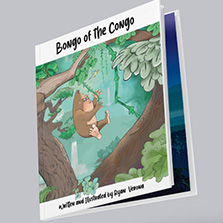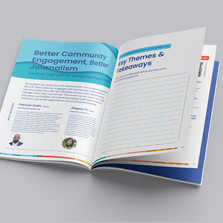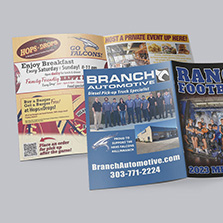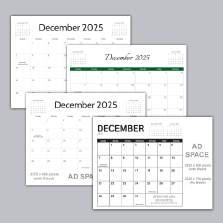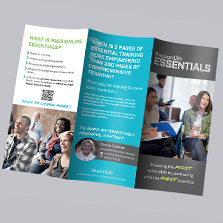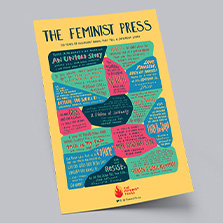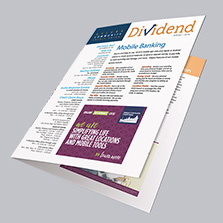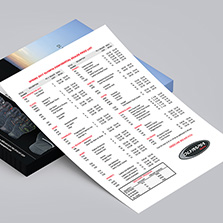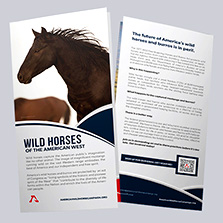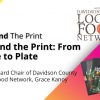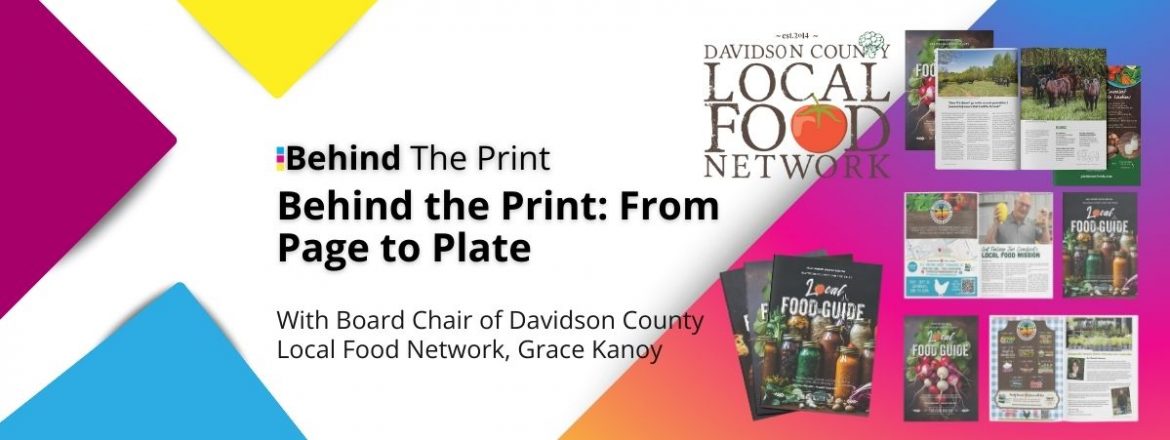
Behind the Print: From Page to Plate
In this episode of Behind the Print, we’re joined by Grace Kanoy, Board Chair of Davidson County Local Food Network.
From aging farmers and new growers just getting started, to consumers who are rediscovering the power of seasonal, local food, Grace works at the intersection of storytelling, economic development, and community health. Her team’s Piedmont Fresh initiative and beautifully printed local food guides are helping farms scale beyond the farmers’ market while educating the public in a tangible, memorable way. Whether you are a marketing pro, small business owner, graphic designer, or print enthusiast, this conversation shows how thoughtful print pieces can anchor real change in a community and keep local food top of mind all year long.
Below, you’ll find the transcript of our conversation, edited for clarity to ensure easy reading. If you want the full, authentic experience, make sure to check out the video attached below.
Connor: Welcome back to the Behind the Print Podcast, where we feature industry leaders and uncover the creative minds and their businesses within the world of professional printing. Our mission is to provide you with inspiring, actionable resources that elevate your business projects and accelerate your journey to excellence and profit in print.
Today’s episode is From Page to Plate, Educating, Connecting, and Nourishing Communities. Joining me is Grace Kenoy, board chair of the Davidson County Local Food Network. Welcome to the podcast.
Grace: Great. Thank you for having me.
Connor: Thank you for joining us. If you’re ready, let’s dive right in. Sound good?
Grace: Sounds good to me.

Connor: Tell me a little bit about yourself and what you do.
Grace: By day I am a videographer and photographer, and one of the areas we specialize in is farming and local food. As part of our community service, we are very invested in local food advocacy.
Our local nonprofit is the Davidson County Local Food Network. I’m the board chair for that food council. Part of our outreach is local food education, and it is also an economic development outlet for our farms and for value-added products. So when I am not doing my day job, a lot of my time is spent there.
Connor: How did you get involved with the Davidson County Local Food Network?
Grace: My husband and I are co-founders of the Food Network, along with our county health department and our cooperative extension. There were about ten of us to start, a mixture of food advocates, health advocates, and farmers.
We started this group to bring back local food. People often do not realize that our food is shipped from all over the world. As a result, we have decentralized food from our own neighborhoods, even though we are fundamentally an agricultural county. We are in Davidson County in North Carolina.
There is a farmer from Goat Lady Dairy in a neighboring county. I heard him speak once and he said, “Everybody wants to change the world, but you can’t change the world, but you can change your corner of the world.” That was very accessible to me. I thought, we can do small things, and if everybody does a small thing to make their communities better, then inevitably you change the world into a better place. That idea guided our direction.
“We started this group to bring back local food. People often do not realize that our food is shipped from all over the world. As a result, we have decentralized food from our own neighborhoods, even though we are fundamentally an agricultural county. We are in Davidson County in North Carolina.”
For us, the low-hanging fruit was helping our local farmers and our farmers’ markets. That is where we started. Over time, some of these farmers were ready to scale beyond the market, so we started our Piedmont Fresh Food Hub initiative. Part of our outreach is through social media, but also through printing.
Many people feel that print is outdated, but I am a big fan of magazines and of tactile, tangible things. When you invest in printing, you want to do quality. I am the kind of person who will save a magazine for a recipe or because it is beautiful and I want to look at it all the time.
My background is in photography and video, so I value imagery and storytelling because it resonates more deeply. We chose the “low-hanging fruit” and the mediums we were comfortable with, and used them to reach out to our community.
Connor: You mentioned farmers. What else can you tell me about your typical clientele?
Grace: Historically, this area had a lot of tobacco farming. Tobacco has changed, and with that the industry has changed. Yes, it was an agricultural area, but not everyone did commercial vegetable farming. Many people grew vegetables for their household, not as a business. Commercially it was mostly cotton, tobacco, and maybe some commodity grains, which still happens.
There is a huge transition underway. We have many farmers aging out, and a new group coming in. Many of them have not come from farming backgrounds. We are losing a lot of farms because it is a very difficult career. At the same time we have this new wave of young farmers who need all the help they can get.
When you are new, not only are you learning how to farm, but also how to run a business. People forget that. Growing food is one thing. Selling, managing, logistics, all of that is a whole other thing.
Our main clientele are small to medium-sized farms. A small farm could be as little as an eighth of an acre, up to 25 acres. That is not a huge amount of land, but you can feed quite a few people if you manage those farms correctly and if they have markets.
It has been difficult to establish year-round markets when the industry is dominated by farms with thousands of acres and by overseas import and export. So those are the people we advocate for in our area.
On the demand side, we are essentially targeting everyone around us, trying to get people in the habit of buying local.

Connor: You mentioned the area essentially transitioned from tobacco to food crops. Was that transition quick or slow?
Grace: Very slow. First of all, you have many people who own land but are not actually farming it anymore.
We have several forces working against us: commercial real estate development, the fact that land is expensive, and the reality that when you buy land, you might not get a return on your investment through farming. The rate of return is much slower than if you did a housing development or a data center.
But when you look at the big picture, you really do not want to be shipping food from 3,000 miles away. We saw those disruptions during COVID. From a food security standpoint, you want to have food available locally. If a major growing area fails, you want a backup source from another region.
People do not always think about that systemically, and that is what we are trying to establish. We are not the only group. This is happening all around the nation. You have groups trying to rebuild what was once normal and make it normal again.
“But when you look at the big picture, you really do not want to be shipping food from 3,000 miles away. We saw those disruptions during COVID. From a food security standpoint, you want to have food available locally. If a major growing area fails, you want a backup source from another region.”
Connor: That idea of getting back to “normal” is really interesting. Going back to your audiences, what problems do you typically help them solve?
Grace: When I say “clients,” we actually have two groups we are targeting. We are trying to help farmers, and we are trying to help consumers.
Food is very convenient. Fast food is convenient, convenience store food is convenient, processed food is convenient. That convenience is what we are fighting against. The data shows that ultra-processed food is essentially killing us. Just going back to cooking and eating more simply with fresh, seasonal food can make a huge difference.
Some of our outreach is about reconnecting people to how easy it can be to cook or to prepare basic meals with seasonal food, both from a health standpoint and from a community-building standpoint.
So we have two target audiences: our farmers and the consumer. We need both ends. We need to improve supply, and we need people to buy local and feel good about it, knowing they are investing in their community and in their health.
We are also trying to help the next generation of farmers. We have an aging farming population. At our farmers’ market, some of our oldest farmers are 93 and 94. They are still farming, but semi-retired. Then you have this new group in their 30s, 40s, and 50s. Some are semi-retired and considering a different career. Many do not come from a farming background.
So they need help with everything: deciding what to grow, whether that is microgreens, mushrooms, an apple orchard, or something else. All of those are very different businesses. There is a lot of education needed on the farming side.
Once you grow the food, there is the whole food safety component of getting it from the farm to the consumer. There are many steps in that chain and a lot of people touching the food. By the time it gets to the grocery store, it has gone through many hands, and all of that has to be safe.
We are working on that piece, and also trying to increase demand by telling people, “You can buy it right here.” You do not have to go far. We teach that food is seasonal. Apples really are a fall crop. We are just lucky to have logistics that let us eat them year-round by shipping and refrigeration.
There is an education component, and we partner with others to offer occasional cooking classes. We work on every part of the chain, from the farmer to the consumer. That is how you rebuild. It is a slow, steady process, not a quick fix. It might take 120 days to grow one vegetable, and if weather is bad and the crop fails, you cannot replant until the next season. People do not always understand how fragile and difficult growing food is.
We also encourage people to do small gardens, to get back to the earth. It might sound a bit “hippie,” but there is a very pragmatic element. Knowing where your food comes from, having a sense of control over what you eat, taking control of your health, and investing in your community all matter.
We have been doing this since 2014. It has been steady, and not everything works smoothly every year. Reaching people and getting solutions to stick is difficult. We know many of the solutions. The hard part is spreading the word and getting that public element to click.

Connor: Does the Davidson County Local Food Network focus primarily on produce, or does it include livestock as well?
Grace: Anything agriculture, essentially.
We have several farms raising sheep, goats, beef cattle, chickens, and turkeys. When we talk about chickens, it might be meat birds or egg layers. We also have a rabbit farmer, which is less common now, although it was common back in the day.
We also pay attention to how they farm. Soil health is critical. If the soil is healthy, the forage is healthy. If the forage is healthy, the animals are healthy. When the animals are healthy, you don’t have to use antibiotics. So many things come back to the health of the soil.
There is more and more data regarding soil health, and the soil itself is almost like a living being. There is so much going on in there. It is not just about adding fertilizer. There is a real microbial system at work. When that system is healthy, plant life is healthy. You can do a deep dive into that topic. It is all connected.
“Soil health is critical. If the soil is healthy, the forage is healthy. If the forage is healthy, the animals are healthy. When the animals are healthy, you don’t have to use antibiotics. So many things come back to the health of the soil.”
There is also a growing demand for high animal welfare. People are seeking meat from farms that treat their animals well.
Connor: Free range and so on.
Grace: Yes, free range, and even how they manage that free range. There is a lot of interest in regenerative agriculture. You can take barren land and use animals to regenerate soil quality through the way you graze them. There is so much there.
In local food education, you do not want to overwhelm people, so you give them small stories. Storytelling is one of our main tools. It helps us educate the public, build brands for these farms, share our own brand, and do something meaningful.
Connor: That is fascinating. You do not usually think about soil as being “alive,” but when you stop and consider it, there must be millions of microorganisms in there. And if they are happy, everything else is happy.
Grace: Exactly. Disease starts from the soil. If the soil is depleted and there is no nutrition, that breakdown affects everything up the chain. Health of the soil really is health of the human being. You cannot separate yourself from that.
Connor: It is almost like gut health in a way.
Grace: It is exactly like gut health. The more diverse foods you eat, the more diverse your gut biome. That affects your brain health, your immune system, everything. There is more and more research suggesting that conditions like Alzheimer’s and Parkinson’s have connections to gut health and food diversity. Eating better quality food contributes to better overall health.

Connor: You are a nonprofit, right?
Grace: Correct.
Connor: How does the Davidson County Local Food Network stand out from other nonprofits?
Grace: We call ourselves a “network” because we work with many nonprofits. We have lots of partnerships and stakeholders. Our role is to facilitate and connect, not to duplicate.
We already have a health department. We already have the cooperative extension. What we are really good at is connecting resources and amplifying the work they are already doing. That is a big differentiator for us.
We started in 2014, but we did not become a nonprofit until 2022. Part of the reason is that we felt we needed to learn and understand our community before we could do meaningful work. I think people are often rushed to start a nonprofit, and that can be a mistake. You should get involved with what already exists.
By doing so, you see who is doing the real work, what kind of help they actually need, and where the gaps are. Then, if you start a nonprofit, you can fill what is missing rather than recreating the wheel.
We found that our greatest asset was connecting resources. That is why we are called the Davidson County Local Food Network. We are here to amplify existing work and connect it to build a stronger system overall.
“We started in 2014, but we did not become a nonprofit until 2022. Part of the reason is that we felt we needed to learn and understand our community before we could do meaningful work.”
Connor: Can you tell me how print has helped elevate your organization?
Grace: People talk a lot about social media, and that is one tool. But people still love a physical element, something you can put into their hands like a gift, something they can refer to over and over like a reference book.
For us, the Local Food Guide is that piece. It is our way of handing something to someone and saying, “Look, in the middle there is a directory. You can find all the farms.” Then we amplify that with different stories.
For me, print is not dead at all. But if you are going to print, you need to put effort into the content. When we handed out the guide at Earth Day, people loved it. There is a tactile experience when you hand someone a booklet or magazine. They open it up and say, “Look at everything in here.” It is a pleasant surprise. It is not just a brochure. It is a keepsake.
Our goal is for it to stay on their table for a while, so they keep coming back to it. We have a local magazine here called Our State Magazine that people save. That is the kind of print piece I want to hand out representing our organization. It should be beautiful and helpful. Quality and usefulness are the two things.
When we hand out something tactile and beautiful, people want to keep it. They refer to it. We have had people tell us, “I keep all the issues,” because the stories are great and the directory is helpful. People still notice paper quality, too. They can tell the difference.
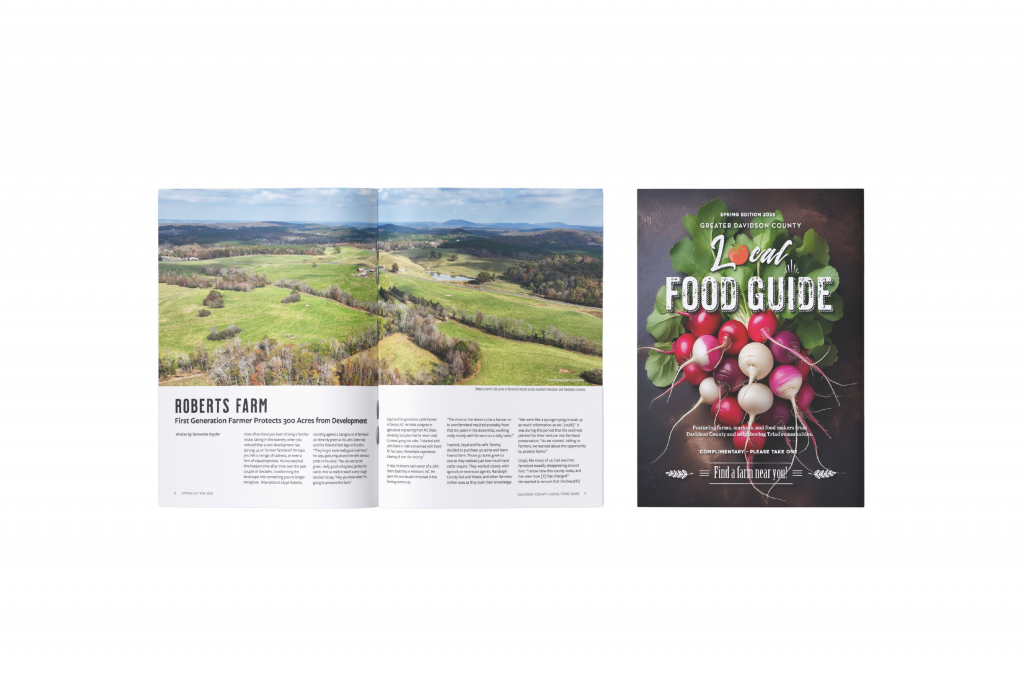
Connor: A lot of people see print as strictly visual, but it absolutely has a tactile side. The texture of the paper really makes an impact.
Grace: This is probably our third year doing the guide, and we were able to get funding to continue for another three years. During that time I have been experimenting with different paper stocks. People notice the difference.
Each issue in the first two years was different because I was trying to figure out how high we could go in quality for our budget. I have had people say, “This one feels different. I think this paper’s better.” So people notice.
We get requests now. For example, today there was a fundraiser for the local news. They emailed and asked if they could get copies of our Local Food Guide for a fundraising event at a local store. It is all connected. It helps local food and local businesses.
That is what we do best. We are helping everyone in our community. The fact that other organizations request the guide for their own events shows the quality. They appreciate the physicality and the content.
Connor: We definitely appreciate you printing with us. I also saw on your website that you have a couple thousand copies of that booklet out around Davidson County, being handed out at farmers’ markets and other events. Even though it is not connected to the internet, it still spreads far and wide.
“That is what we do best. We are helping everyone in our community. The fact that other organizations request the guide for their own events shows the quality. They appreciate the physicality and the content.”
Grace: Oh yes. We have people call and ask, “Where can I get a copy?” We put them at the tourism center because new people are always coming into town. It becomes a one-stop piece: “Look how pretty this is.” It turned out great.
I appreciate you all because you check if our resolution is correct. There are little things you do that make it easier for us. You are like our second set of eyes. I am a huge fan. When I design these pieces, I want to make sure they are impactful.
We do a lot of photography. I want the pictures to be strong, and I want the print quality to support that. People comment on the paper quality all the time. They really can tell the difference.
Connor: Can you tell me about any major milestones or accomplishments that have defined the Davidson County Local Food Network?
Grace: One big milestone is Piedmont Fresh, our online farmers’ market. We have been steadily building it as a complement to the existing physical farmers’ markets, which are seasonal. Piedmont Fresh helps extend the market season for our farmers.
We now have pickup sites in five different areas, four of them outside our county. We are expanding beyond Davidson County into neighboring counties to increase access to our farms. Our farmers are not only in Davidson County. Farms are scattered across our region because there are not that many small diversified farms overall.

Connor: That was actually one of my questions. Is it restricted just to Davidson County, or does it include surrounding areas?
Grace: It would be impossible to restrict it to just Davidson County. We need all the farms we can get. We support farms around Davidson County.
We are in the Piedmont Triad in North Carolina. We have to look at this regionally. We happened to start here, but our responsibility is broader than one county. We want to grow this in a way that reaches as much of our region as we can handle.
There are other organizations we work with that handle Western North Carolina or the Triangle region. There are many of us doing this work, and we hope to fill the gaps as a state network over time.
We serve regional farmers in Davidson, Forsyth, Rowan, Davie, Randolph, Guilford, and more. As Piedmont Fresh has expanded, the Local Food Guide has become more important because we now distribute in Forsyth County and hope to grow into other counties.
Our goal is to print 10,000 copies. Right now we are at 2,000 to 3,000. Growing to 10,000 would let us distribute further into other counties and let more people know we exist.
Connor: We can definitely give you a hand with that. It also sounds like a great community.
Grace: Yes, it is wonderful, and the weather is beautiful today, so that helps.
“Our goal is to print 10,000 copies. Right now we are at 2,000 to 3,000. Growing to 10,000 would let us distribute further into other counties and let more people know we exist.”
Connor: Can you tell me about any challenges or obstacles that are holding you back right now?
Grace: There are always challenges and obstacles, especially with farming.
Weather is a big one. It is more unpredictable, and that affects crops and yields.
Another challenge is that we are essentially a small business ourselves. We are trying to grow consumer demand, and that is not easy. We are competing with big grocery stores. It really is a David and Goliath scenario.
We have to be patient and at the same time consistent and persistent in our efforts. So I would say weather and the fact that we are at a disadvantage in terms of marketing budget are our biggest obstacles.
Connor: You cannot control the weather, but you can at least control your strategy and how you use your resources. A different question for you: if you had a day completely free to spend however you would like, how would you spend it?
Grace: Probably outdoors. Right now fall is about to hit. If I had a full day, I would spend it outside, probably in my garden, and then later I would go mountain biking. Something simple. I really enjoy just being outside.
Connor: I imagine you are about to get all kinds of fall foliage, too.
Grace: Yes, we are. It is a great time to visit North Carolina.

Connor: One last question. How can our listeners get in touch with you, collaborate more, or learn more? What is the best way?
Grace: Our website is davidsoncountyfood.com. It outlines all of our services and ways to get involved. You can donate there.
We are also hoping to have sponsors for our Farm to Pantry program. Most people are used to donating canned goods. We hope people will also consider donating, say, ten dollars to our Fresh Food Fund.
We have seen a drop in support for our food pantries. We would love to supplement what they already have with fresh food. You can donate to the Fresh Food Fund through Piedmont Fresh if you live in the area and want to become a customer.
If you are not local, you can donate to the Davidson County Local Food Network. That money goes toward local food education and our Farm to Pantry programs, making sure fresh, local food reaches people who need it most.
Connor: I would say that is a wrap on another episode of Behind the Print. Thank you to our listeners for joining us as we explore the artistry and innovation of the printing world.
Remember, having a strong vision, building the right strategy, and using tools like print to amplify your message will make your brand stand out from the crowd. If you enjoyed today’s episode, be sure to get your sample pack today from printingcenterusa.com and share it with your fellow business enthusiasts.
Until next time, keep those creative sparks flying, and remember, there is always more to discover behind the print.




